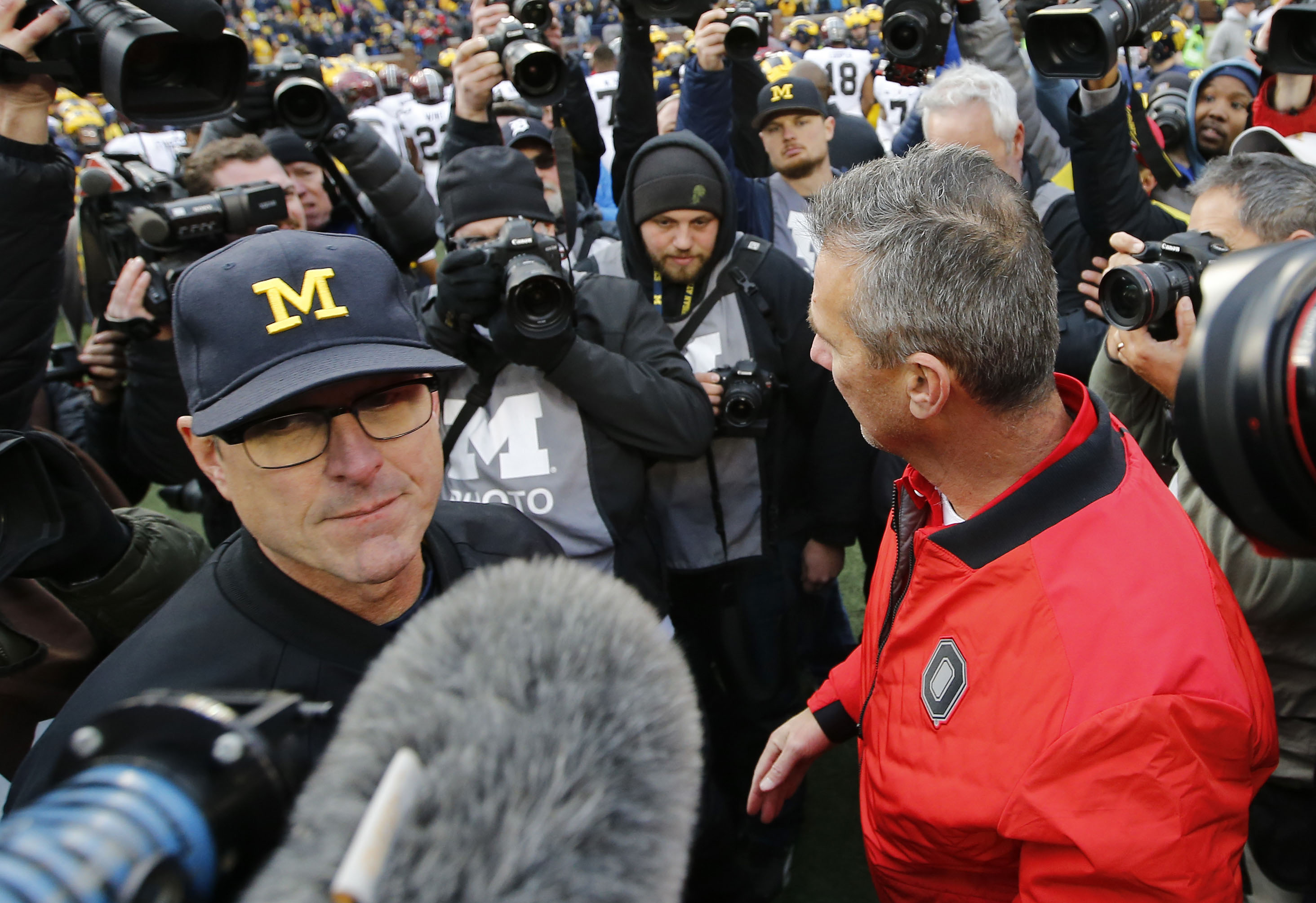Ad Disclosure

Break up the B1G East! Conference needs to try again on divisional alignment
By Luke Glusco
Published:
In the fifth season of its current divisional alignment, the Big Ten scores off the charts for geographic integrity but isn’t pushing the needle on the common sense meter.
It’s past time to try again, that much is obvious from the anti-climactic matchup for Saturday night’s conference championship game: No. 6 Ohio State (11-1) vs. No. 21 Northwestern (8-4). The true league title game happened last weekend, when the Buckeyes kicked the crap out of Michigan.
Northwestern will enter Lucas Oil Stadium as a 14-point underdog and most likely leave as the fifth straight West representative to fall short. The Wildcats have had a nice season, winning 7 of their past 8 and hanging tough against Michigan and Notre Dame. They’ve also lost to Akron and squeaked by Big Ten doormat Rutgers 18-15.
Regardless of what happens Saturday night, it won’t change the fact that the Big Ten never should have scrapped the Legends and Leaders divisions (other than possibly the names). The addition of Rutgers and Maryland for the 2014 season did not require the major overhaul the league made.
Stadium capacity, I will argue, provides a pretty darn good indicator of a program’s prowess. And given that Michigan, Penn State and Ohio State have the three biggest football venues in the country based on capacity, it makes no sense to jam them into one division.
In big-time college football, size and strength matter. That’s true at the player level; that’s true at the program level. Nobody builds 100,000-plus-seat cathedrals that can’t be filled. Those monstrosities indicate resources, tradition, passionate fan bases and recruiting power.
To prove the point: Eight college stadiums hold 100,000-plus fans. Six of those 8 are among the Playoff selection committee’s top 14 teams. The Big Three of the B1G East hold spots 6 (Ohio State), 7 (Michigan) and 12 (Penn State). Northwestern, the only league school that plays in a sub-50,000-seat stadium, ranks 21st.
Other than Central Florida, every team in the committee’s top 10 can pack in more than 77,000 for home games, ranging from Notre Dame on the low end to Georgia at roughly 93,000 and then on up to the 100K club.
One can argue that sports runs in cycles, and that Nebraska, Wisconsin and Iowa — the three big dogs, by stadium size, in the B1G West — will rise again to balance out the league. Or that the Jeff Brohm golden era is just getting started at Purdue. Or that recently named B1G Coach of the Year Pat Fitzgerald can sustain Northwestern’s feel-good, underdog story.
I wouldn’t bet on it.
Despite some recent off-field turmoil and on-field stumbles, the East’s Big Three isn’t going anywhere but up. Most seasons, they’ll only get knocked down by each other. They need to justify those sprawling stadiums with national success, and the programs will spare no expense to do so. And their marketing is working: all three packed their stadiums beyond listed capacity ON AVERAGE in 2017.
It’s time to fix the Big Ten’s imbalance.
Here’s my proposal to even things up: Split the league into North and South divisions and swap the Michigan schools with Purdue and Illinois. Here’s a visual aid, courtesy of Twitter, of the current configuration:
https://twitter.com/IllinoisLoyalty/status/326306447535243265
Without drawing lines of latitude on a map, I can’t say my alignment keeps perfect geographic integrity. Some quick research, though, suggests Lincoln, Neb., is ever so slightly further north than State College, Pa. So let’s get on with it.
My North and South, with 2017 average home attendance, in order based on this year’s league records (ties broken by head-to-head or overall record):
[table “” not found /]Fairness and rivalries: Count only division games in the division standings. This year, Northwestern got a huge break not facing Ohio State or Penn State and drawing Rutgers (along with Michigan and Michigan State) from the East. … To maintain traditional annual rivalries, have one permanent cross-over game. If Michigan and Ohio State need to play every year, let them have at it. I’m not sure if Penn State or Michigan State is really gung-ho to win the Land Grant Trophy, but whatever. I’d set the permanent cross-over games as Ohio State-Michigan, Penn State-Michigan State, Purdue-Wisconsin, Indiana-Iowa, Maryland-Nebraska, Illinois-Northwestern and Rutgers-Minnesota. (Someone has to get Rutgers — your welcome, Gophers fans.)
This change would greatly improve the chances for top 10 showdowns in the B1G title game, thus boosting the league’s odds to get a team into the Playoff.
While waiting for college football to fix its terrible Playoff structure, the Big Ten might as well get its own house in order. This plan, as is or with a few tweaks, makes a lot of sense. Doesn’t it?
Luke Glusco is a Penn State graduate and veteran journalist. He covers Penn State and occasionally writes about other Big Ten programs and topics. He also serves as the primary copy editor for Saturday Tradition.